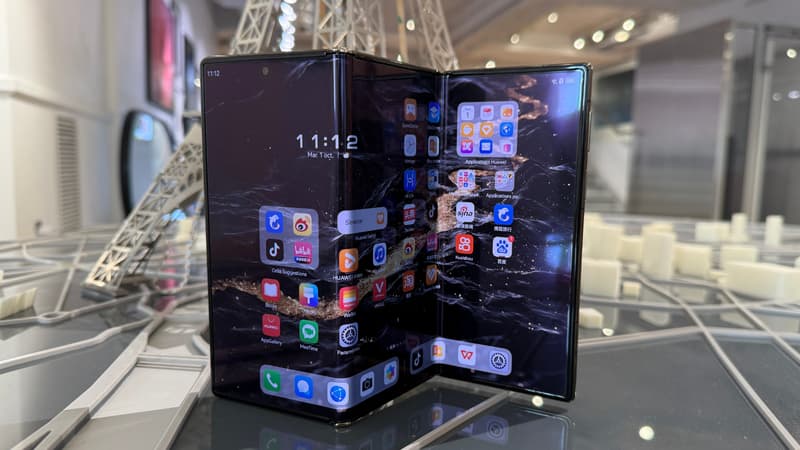It’s a real open book in your hand. Much more than the Samsung Galaxy Z Fold6, the Honor Magic V3 or the Google Pixel 9 Pro Fold. The Huawei Mate XT certainly belongs to the foldable smartphone category, but it aims to stand out in a different way. Firstly because, unlike its acolytes, it is developed in three parts and not two, maintaining an identical concept.
Completely closed, it is a smartphone that is a little thicker in the hand (12.8 mm thick) than the average and even than the folding ones that compete for thinness. Unfolded, it’s the king of finesse, barely thicker than the USB-C port it uses for charging (3.6mm). And there, it slaps all the competition, but is proud to show a thickness of 5.1 mm.
The Companion No is light (298g) and when folded feels like a wallet in your hand. But it is solid, the double hinge reinforces this feeling by requiring a little force to open, but guaranteeing strong support when you want to place it in a Z or in a tent.
Use in all directions and all formats.
The Mate XT has a very nice 6.4-inch external widescreen display. As is often the case with foldable smartphones, when you hold it it is quite thin and narrower than a classic smartphone. Once deployed we find a 10.2-inch screen, adding the external screen to the “internal panel” to give the sensation of a tablet. And then the whole experience takes shape.
You should know that the Huawei smartphone offers multiple configurations. Therefore, you can open or fold it completely to use one or three screens, but also choose to leave the external screen in place to use the Mate XT in book format with two screens (about 8 inches in square format).
The fold is present, but it does not attract attention at all, whatever the format chosen. The screen offers an adaptive refresh rate, but it does not exceed 90 Hz. On it we watched TikTok videos, browsed web pages, processed texts, etc. The smartphone surprises with the fluidity of the display and the responsiveness of the screen.
Importantly, whether you hold the device vertically or horizontally, the switch happens automatically, and if you had two apps open, its screen adapts immediately, even if you fold one side of the panel or close it completely. stuff. Even on the external screen, dual display of applications is possible. It’s a shame that with such a large screen you can’t display three applications at the same time.
In the photo, we find a triple module on the back in a very fashionable octagonal central area that also recalls the new Huawei watch faces. It is made up of a 50 Mpx main sensor, a 12 Mpx ultra wide angle and a 12 Mpx periscopic zoom with 5.5x optical zoom. A proposal that announces versatility and an effort in photography, also a hallmark of the Chinese giant.
100% Huawei in substance and form
The smartphone is very thin, because Huawei has managed to divide its battery into three, one per part, without compromising the promised long-lasting autonomy (5600 mAh). A foldable format with such a large screen will require much more battery use than a traditional smartphone and tablets usually have batteries of at least 10,000 mAh for longer life. Here the usage is obviously not exactly the same, but we probably shouldn’t expect miracles either.
Introduced in China on September 10, the Mate XT is not currently planned for Europe. Sold between 2,500 and 3,000 euros in China, it already has nearly 6 million pre-orders registered in a market where Huawei returns with its latest Mate 60 and Pura 70.
Although it has been hit by the boycott decided by the United States for more than five years, Huawei shows that it still has its resources and innovation capacity intact. In the planning all this time, the Mate XT is the best expression of a response from the brand that has made design its workhorse for smartphones such as tablets and headphones.
The device runs on HarmonyOS, the in-house operating system without a suite of apps from Google and others, but with their alternative stores, and is powered by the latest Kirin chip designed in-house. We may have to keep a close eye on the brand again if it ends up doing everything on its own, like Apple or Google. Except for one detail: due to the lack of Google services, its smartphones remain unusable for the general French public.
Source: BFM TV


